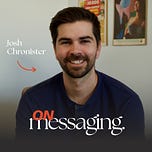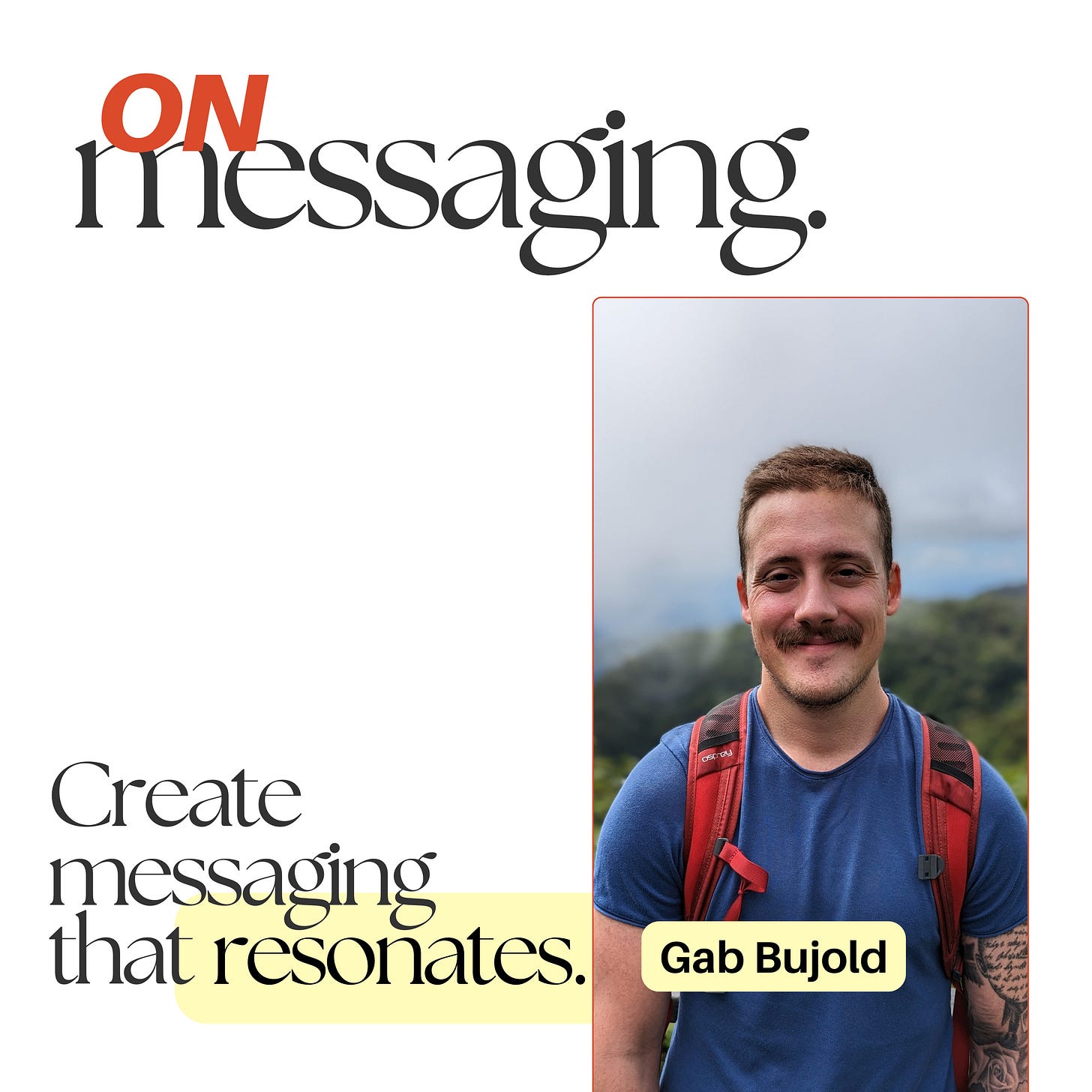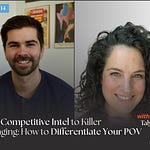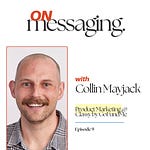Listen now on YouTube, Spotify, and Apple!
On the show today, we have Gab Bujold, messaging strategist and co-host of the We’re Not Marketers Podcast.
Gab’s helped 30+ B2B SaaS worldwide nail their product messaging.
Here are the key themes and ideas from my time with Gab:
Messaging is a Long-Term, Iterative Process:
Messaging is not a "set and done" task, but rather a continuous initiative that needs to adapt to changing market conditions, competitors, and customer needs.
"Messaging to me is a long-term initiative because it's never a set and done thing, right?... Markets are shifting, new competitors are going in... There's always moving parts."
You need to prioritize your understanding of why customers buy, love, and stay with your product/service. It’s fundamental to messaging.
The "Product Marketers Aren't Marketers" Debate:
Gab and his co-hosts (Eric Holland & Zach Roberts) on the We're Not Marketers podcast hold the controversial view that product marketers aren’t traditional marketers.
The origin of this belief stems from the observation that a PMM’s skills don’t directly translate to a traditional marketing role focused on lead generation.
Product marketers are viewed more as strategic thinkers, enablers, and business strategists.
"[Speaking about Eric] Basically, I very much believe that PMMs are not marketers... my skills from being a PMM don't really translate to the new role that they're asking me... So he just said, well I mean we're not even marketers and then it kind of just stick..."
The purpose of the debate is to remove the existential crisis in product marketing, define the role, give more influence and set up guard rails for the function, not to diminish or demean the role.
I argue the opposite, that product marketers are marketers, because they do the core functions of marketing ("4P's": product, price, promotion, place).
Gab’s counterargument is that “everyone does marketing” and the focus has been lost on the core principles. It was a fun little debate :)
The Importance of Customer Understanding:
The process of building a strong messaging foundation starts with a deep understanding of customers.
Key questions to ask yourself:
"How are we bringing money today?"
"Why are we bringing money today?"
"Why do people love us?"
"Why do they keep staying with us today?"
This understanding encompasses customer problems, aspirations, fears, and frustrations.
Gab’s approach involves reaching out directly to customers to gain understanding through direct conversation. He emphasizes that it's not a sales call, but a genuine effort to understand them
Active listening and empathy are crucial.
The goal is to listen to understand, not to listen to fix.
Message Market Fit (MMF):
MMF is defined as the "baby step" to product-market fit.
MMF is an indicator of whether messaging resonates with the Ideal Customer Profile (ICP) under current market conditions.
It is not a one-time event, but a continuous assessment that requires iteration.
"To me message market fit is kind of like the baby step to product market fit. It's an index that tells you if your messaging resonate with your ICP with the current market conditions.”
MMF is a sign to double down on marketing efforts and push campaigns harder.
The components to achieving MMF include: clear ICP, key messages, and the ability to test them effectively.
30% of MMF is based on the ICP. If you get the ICP wrong, then your foundation for success is flawed.
Message Testing:
Message testing requires more than just running A/B tests.
Key steps:
Ensure your ICP is clear.
Make sure you have enough volume to test, to reach statistical significance.
Categorize your data into qualitative (e.g., ICP alignment, differentiation, emotion, clarity, consistency) and quantitative (e.g., reply rates, conversion) components.
Gab uses LinkedIn Text Ads as a fast and cost-effective way to test messaging.
Message testing is done to see if the results match the hypothesis and to make adjustments based on the data.
Differentiation:
The first step to differentiation is understanding the current market and context.
Don't copy competitors. Instead, develop a unique point of view that might be considered “unhinged” or “different”. Kind of like We’re Not Marketers.
Focus on your customers and why they choose you over alternatives.
The key is to offer a different experience, value, or product, not just a better version of what's already out there.
"The first step to differentiate is to understand what's the current state, right? What's your market? What's your context? What big shift happened? And then ensure you understand why would people go with you instead of going with the competition..."
Use questions during customer interviews to understand why customers choose you over alternatives to help identify differentiators.
“What are the 3-5 solutions you looked at before choosing us?”
Ask prospects “In what category would you put this product?” to gauge how well your positioning is working.
Connection between Business, Product, and Positioning Strategy:
Messaging falls under the positioning aspect of the overall strategy.
Your positioning directly impacts how relevant your messages are.
Understanding your product strategy and what problems you’re trying to solve in the context of the market drives your messaging.
Business > Product > Positioning strategy. They should all flow together and align. This is where the concept of PMMs being business strategists originates. PMM are the most well-rounded department (or should be!) in the org. they know the market, customers, and product.
The Power of "Without":
The word “without” in messaging adds definition and eliminates doubt to drive home the point of what a product/service offers and what problems it solves.
“Without” is a word that can be used in defining positioning, setting clear messaging and written in the actual copy for your audience.
Example from Freckle.io homepage: “It’s like Clay…without the learning curve.”
Actionable Takeaways:
Adopt a long-term mindset when it comes to messaging, continuously refining based on feedback and market changes.
Seek a deep understanding of your customers through direct conversations and listening to understand (not to fix).
Prioritize message market fit as a crucial step before product market fit.
When testing messages, don’t start with A/B testing. Ensure you have a clear ICP, a big enough testing volume, and you’re categorizing data correctly.
Dare to be different by developing your unique POV. Don’t copy competitors.
Ask prospects “In what category would you put this product?” to gauge how well your positioning is working.
Leverage the word "without" in your messaging and copywriting to help your audience quickly understand what your product is and the unique value.
Here’s what’s covered in our conversation:
02:04 Are Product Marketers, Marketers?
11:07 Messaging is a Long-term Initiative
13:45 You Need to be Speaking with Customers
17:16 How to Speak with Customer
21:42 Listening to Understand: The Key to Effective Communication
22:34 Junk Food Advice: The Dangers of Surface-Level Messaging
24:35 Understanding Message Market Fit: A Crucial Step for Startups
30:00 Running Effective Message Testing: Steps and Strategies
36:49 Differentiation in Messaging: Standing Out in a Crowded Market
49:55 Aligning Messaging with Business and Product Strategy
55:24 Practical Messaging Advice: Context is Key
Where to find Gab:
Website: https://pressxtomarket.com/
Message Market Fit Scorecard: https://mmf-scorecard-lp.carrd.co/
Podcast: https://www.notmarketers.com/
Referenced:
We're Not Marketers podcast: https://www.notmarketers.com/
Eric Holland: https://www.linkedin.com/in/eric-holland-not-a-marketer/
Zach Roberts: https://www.linkedin.com/in/zgroberts/
Product Marketing Alliance: https://www.productmarketingalliance.com/
Yi Lin Pei: https://www.linkedin.com/in/yilinpei/
BizDev Labs: https://www.bizdevlabs.com/
V2 Cloud: https://v2cloud.com/
Mitch Solway: https://www.linkedin.com/in/mitchsolway/
Lenny's podcast: https://www.lennysnewsletter.com/podcast
Mindstone: https://www.mindstone.com/
Jonathan Hoffsuemmer: https://www.linkedin.com/in/jonathanhoffsuemmer/
Message Market Fit Book: https://www.fltrd.in/book
Robert Kaminski: https://www.linkedin.com/in/heyrobk/
Anthony Pierri: https://www.linkedin.com/in/anthonypierri/
Fletch PMM: https://www.fletchpmm.com/
Zach Messler: https://www.linkedin.com/in/zachmessler/
April Dunford: https://www.linkedin.com/in/aprildunford/
Freckle.io: https://www.freckle.io/
Clay: https://www.clay.com/
PowerBI: https://www.microsoft.com/en-us/power-platform/products/power-bi
Created by Josh Chronister
I interview the best B2B product marketers and tech companies who create messaging that resonates with their buyers. Come learn from them, so you can hit ‘Publish’ with confidence.














